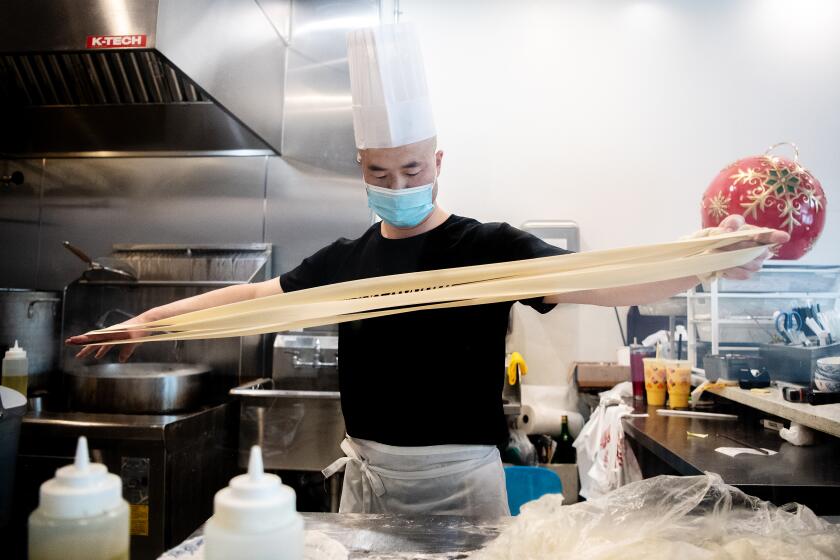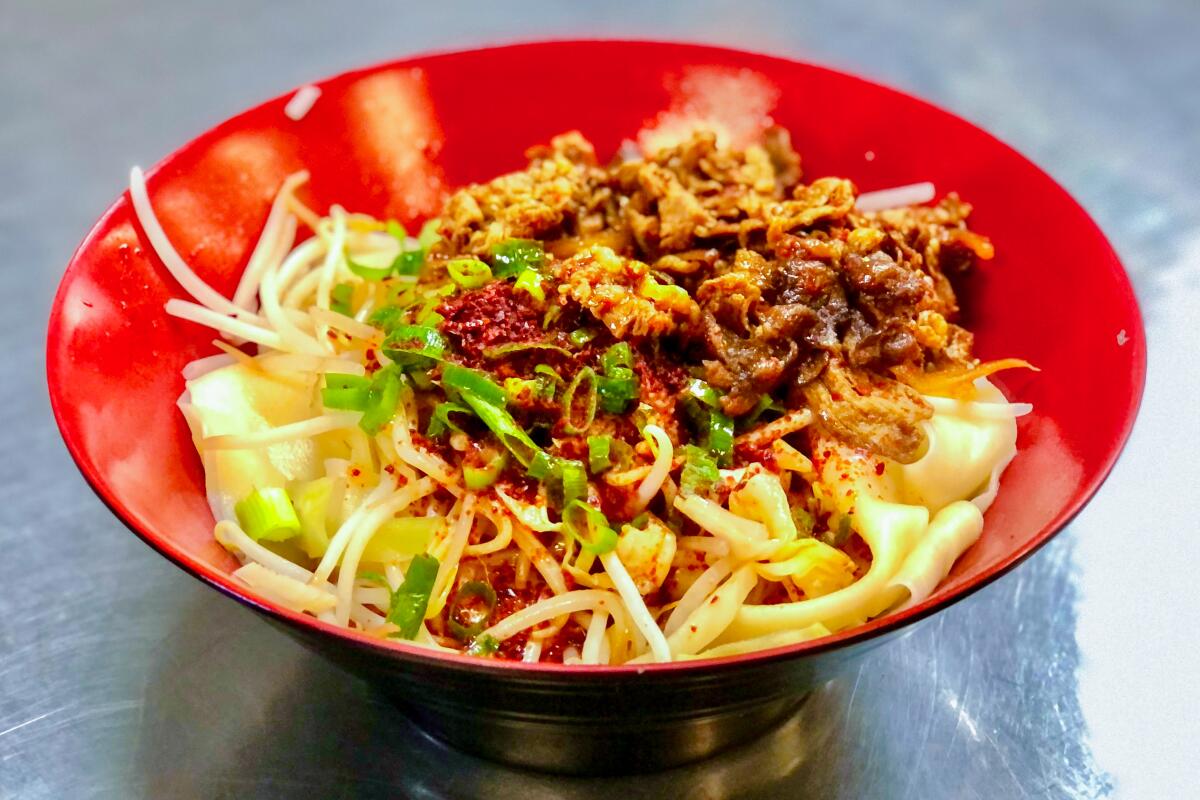
Get the most bang from these hand-pulled biang biang noodle spots
- Share via
Noodles, whether shoyu ramen or tagliatelle alla Bolognese, are — if you eat them the proper way — roisterous with saucy slurping. One noodle dish that’s currently trending, however, cranks the volume up to 11 during the pasta-producing process itself.
The name biang biang noodles, originating from Xi’an, China, refers to the sound of wet dough being slapped against a hard surface when the chef makes them. Biang! Can you hear it?
Xi’an-style restaurants have grown in popularity in the past few years across L.A., as well as in other parts of the country. Since many of the favorite dishes of Xi’an stem from its Muslim quarter, that influence shows up on menus as all manner of skewered meats and vegetables, lots of lamb dumplings, even Chinese haggis and, of course, biang biang noodles.
For Lunar New Year, Lan Noodle makes a single, extra-long noodle that’s more than 5 feet long for good luck and good fortune in the new year.
Known as one of the “10 strange wonders of Shaanxi,” the northwestern province of China whose ancient capital is Xi’an, biang biang noodles can be as wide as a belt, which is why those serious strands also answer to the name of belt noodles. They’re sometimes listed simply as “handmade noodles” on menus at Shaanxi restaurants. “We didn’t think Americans knew what biang biang noodles are,” says Steven Zhang of Noodle Art in Monterey Park.
Typically, the noodle’s dimensions resemble pappardelle rather than something that keeps your pants up. Also, depending on the restaurant, the noodle in your bowl could be one continuous strand (more than a meter long sometimes), which makes for quite the noodle pull.
According to chefs, the slamming of the strands — made with wheat flour, water and salt — optimizes the noodle’s chew, that desired texture called “QQ.” As soon as the ribbons are formed by freshly smacking the dough on the counter and stretching it by hand, they’re given a quick dunk in boiling water.
Cooked and strained, the skeins go into a bowl where aromatic toppings of minced garlic, diced green onions and chile powder are placed on top, then a splash or two of searing hot oil sizzles the trinity into a slick sauce. Add-ons such as cumin lamb, tomato-egg (a scrambled egg with tomato), diced potato or braised pork are common. You can even enjoy rou jia mo, a.k.a. Chinese hamburger (although it’s more like an arepa) as an appetizer.
Here are several of the most bangin’ biang biang noodle spots in L.A.
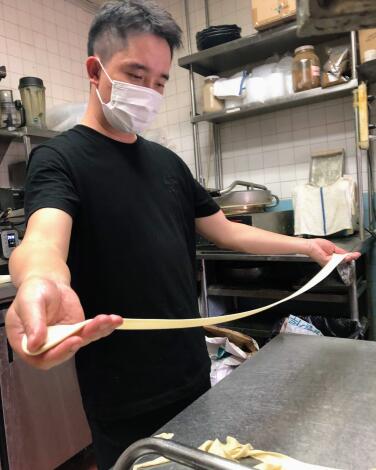
Noodle Art
Be aware, however, that the extra wide noodle isn’t listed as biang biang on the menu; instead they’re called “handmade noodles.” Noodle Art’s most-ordered version of hand-pulled noodles is the three-toppings version that includes tomato-egg, diced potato and braised pork belly bits. “Biang biang noodles are becoming more famous, so we are expanding to outside of San Gabriel,” says Zhang. Certainly since the early days of the pandemic, biang biang noodles have been in the spotlight with growing awareness of the style. Another Noodle Art is slated for a February opening at the Original Farmers Market on Fairfax.
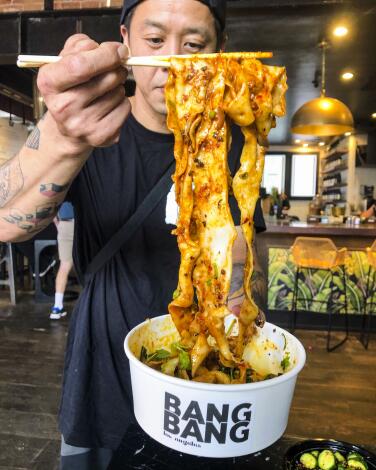
Bang Bang Noodles
He chose the Xi’an-style noodles partly because “L.A. had a huge ramen drive,” Lee says. “Biang biang could be the next big thing.” Of all the biang biang noodle restaurants currently out there, Bang Bang is the only one that pulls back the curtain on the noodle making, confidently demonstrating the creation of the dish for each customer to see as their order is being made. “There is a process that looks like a show. When I was a street vendor, I’m pulling noodles in front of you and giving you service. In a lot of ways it feels like you’re cooking with me. There’s nothing to hide,” Lee explains. The resulting noodles are a perfect union of firm and chewy. There are 12 spices incorporated into the cumin sauce. Indeed, Lee’s detailed sauces raise Bang Bang’s noodles above the rest. Moreover, his house-made pickles add an extra dimension that separates Bang Bang from the pack.
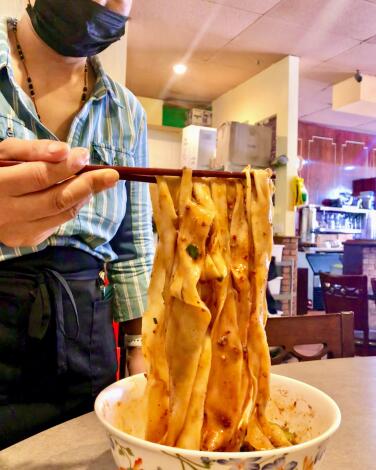
Xian Biang Biang Noodle
“Many non-Chinese customers come in seeking only biang biang noodles,” Shan says. The most requested is topped with tomato-egg, chopped braised pork and zhajiang sauce. All the noodles are handmade in-house, with certain styles like the cold noodles requiring 20 hours to complete.
“Our biang biang noodle texture is comfortable when you eat it. Feels good,” Shan says. And although it seems like many people are discovering the noodle for the first time, Shan explains, “Biang biang noodles originated 2,200 years ago,” which is near the time when the legendary terracotta army, another Xi’an wonder, was created.

Chong Qing Special Noodles
What makes Chong Qing unique as a biang biang noodle purveyor is its Sichuan-forward flavors, meaning more peppery heat than you’d ever get from a standard Xi’an bowl of biang biang. Toppings include a combination of tomato and scrambled eggs, a fried soybean sauce (zhajiang), pickled chiles and chile sauce. The plentiful noodles are hearty with a satisfying chew. Zhajiang and the chile sauce merge wonderfully to impart a wide spectrum of flavors from umami and sweet to salty and spicy. Chong Qing Special Noodles’ version of biang biang noodles brings a lot of Sichuan bang to your biang, so if you can’t handle the burn, request a lesser spice level or none at all.
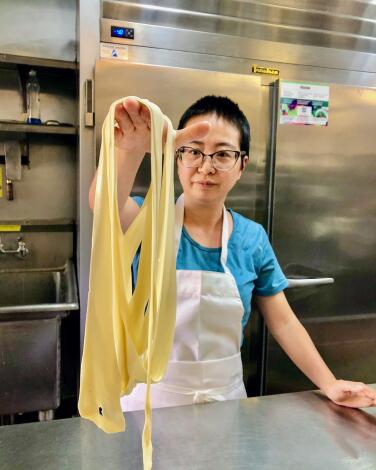
China Islamic
According to Yang, biang biang noodles originated in the Qin Dynasty and began as a peasant food. Once the emperor ate and enjoyed it, the noodles became famous. “‘Biang biang’ is not how we call these noodles. That’s a name for tourists,” Yang claims. You po mian, or oil poured noodles, is how many in China refer to this type of noodles, he adds. The feel of China Islamic’s impressively lengthy single strand occupies the Goldilocks zone: not too chewy and not too soft. A simple sauce coats the noodle with spicy and sour flavors. It’s recommended to add cumin lamb for a truly Chinese Islamic taste of biang biang noodles. Pair the bowl with a mandarin orange soda to give your meal extra dazzle.
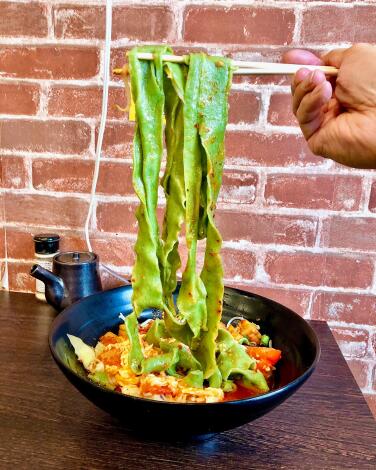
Wen Hui Noodle
A special spinach biang biang noodle is an off-menu item that distinguishes Wen Hui from its rivals. Fresh spinach juice permeates the noodle dough, giving it an inviting green tint. The dough is slapped against a stainless steel counter, creating a loud “biang,” and pulled into a generous serving of supremely fresh, chewy and verdant noodles. Bits of potato, tomato-egg, crunchy bean sprouts, cabbage, fermented black bean, carrots and pepper oil join forces to form a delicious vegetarian bowl of biang biang noodles. Leave out the eggs to make it vegan. Although unique here, spinach hand-pulled noodles are commonplace in Xi’an. Wen Hui’s spinach biang biang is irresistibly slurpable with that special Chinese QQ chew, and visually, it’s the best of the lot.
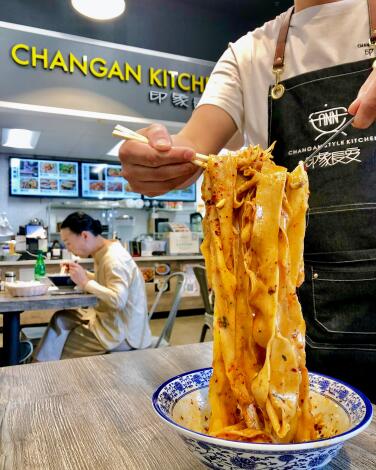
Changan Kitchen
The noodle is served coiled as one long strand. It is a wide noodle, maybe even the widest of any place serving biang biang. An employee explains, “Some customers prefer several shorter pieces of noodle and others like longer.” So if you have a preference, let them know. Meat toppings like chicken or beef are optional. The basic biang biang is topped with garlic, spicy chile oil, bok choy and soy bean sprouts. Beneath the noodles are soy sauce, salt and pepper. Give it a swirl and slurp away. This simple style is really the way to go if you want to enjoy biang biang noodles without all the extra noise. Food court or not, Changan Kitchen’s biang biang noodles are as worthy of a taste as the rest. Since you’re there, maybe pick up a whole rock cod and a pack of century eggs at 99 Ranch.
Eat your way across L.A.
Get our weekly Tasting Notes newsletter for reviews, news and more.
You may occasionally receive promotional content from the Los Angeles Times.
